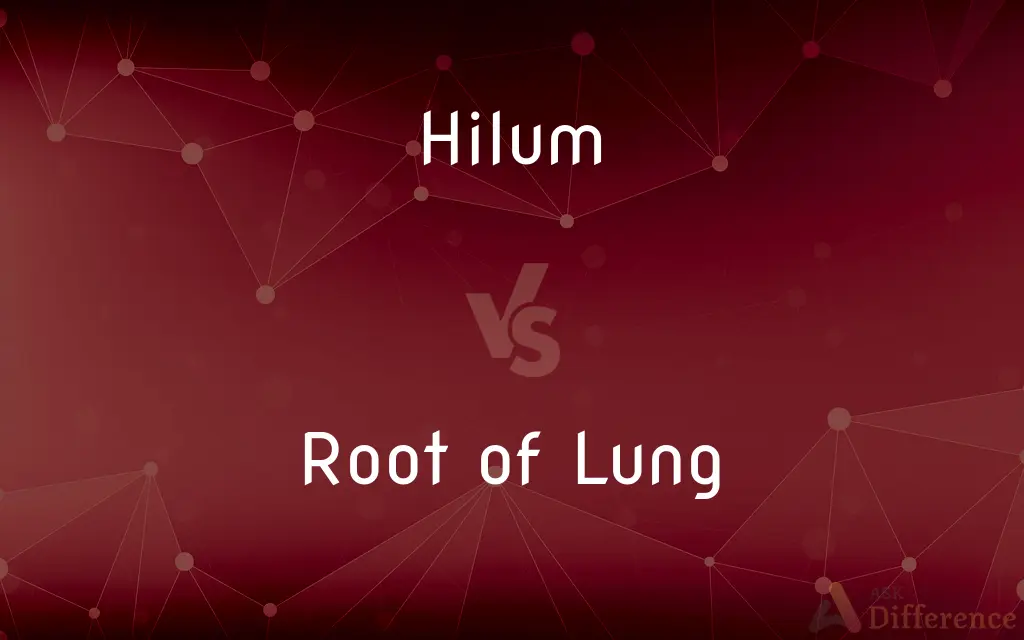Hilum vs. Root of Lung — What's the Difference?
By Maham Liaqat & Fiza Rafique — Published on February 19, 2024
The hilum of the lung is the region through which bronchi, vessels, and nerves enter or exit the lung. The root of the lung comprises these structures (bronchi, vessels, nerves) themselves, anchoring the lung to the mediastinum.

Difference Between Hilum and Root of Lung
Table of Contents
ADVERTISEMENT
Key Differences
The hilum and the root of the lung are closely related anatomical terms that describe different aspects of the lung's connection to the rest of the body. The hilum of the lung acts as a critical entry and exit point located on the lung's medial surface, where structures such as bronchi, vessels, lymphatic vessels, and nerves enter or leave the lung. It can be thought of as a gateway or junction that facilitates the lung's connection to the trachea, heart, and other parts of the body.
The root of the lung, on the other hand, consists of these structures themselves – the bronchi, arteries, veins, and nerves – bundled together with connective tissue. It is this collection of structures, covered by pleura, that forms a bridge between the lung and the mediastinum, providing physical support and enabling physiological functions such as air and flow and nerve transmission.
While the hilum refers to the specific area or region on the lung through which these structures pass, the root describes the collection of these structures as they pass through the hilum. The distinction is significant in medical imaging and surgery, as the hilum can be seen as an anatomical landmark, whereas the root is more involved in the functional connectivity of the lung.
In essence, understanding the difference between the hilum and the root of the lung is crucial for grasping how the lungs are integrated into the body's respiratory and circulatory systems. The hilum serves as the site on the lung where the root structures enter or exit, making it an essential reference point in anatomical and pathological discussions.
Comparison Chart
Definition
Region on the lung's medial surface.
Collection of structures entering or exiting the lung.
ADVERTISEMENT
Components
Entry and exit point for bronchi, vessels, nerves.
Bronchi, vessels, lymph vessels, and nerves.
Function
Serves as a gateway for structures.
Provides physical support and enables lung functions.
Location
Medial surface of each lung.
Extends from the hilum to the mediastinum.
Clinical Significance
Important landmark in imaging and pathology.
Essential for understanding lung's connectivity and functionality.
Compare with Definitions
Hilum
Medial surface region through which lung connections are made.
A tumor was located near the hilum, affecting multiple entering vessels.
Root of Lung
Essential for understanding lung's placement and attachments.
Anatomical studies focus on the root for insights into lung attachment.
Hilum
The hilum is the lung's entry and exit point for structures.
The radiologist noted an enlargement at the hilum of the lung in the X-ray.
Root of Lung
The root includes bronchi, vessels, and nerves anchored to mediastinum.
Surgery involved careful dissection around the root of the lung.
Hilum
Acts as a critical anatomical landmark in lung diagnostics.
The scan focused on the hilum to assess the spread of infection.
Root of Lung
Covered by pleura and involved in lung's functional connectivity.
The pleura enveloping the root of the lung was inflamed.
Hilum
Involved in lymphatic drainage from the lung.
Lymph nodes around the lung's hilum were enlarged.
Root of Lung
Structural complex connecting the lung to the body's systems.
The root of the lung was examined for any signs of disease spread.
Hilum
The scar on a seed, such as a bean, indicating the point of attachment to the funiculus.
Hilum
The nucleus of a starch grain.
Hilum
(botany) The eye of a bean or other seed; the mark or scar at the point of attachment of an ovule or seed to its base or support.
Hilum
(botany) The nucleus of a starch grain.
Hilum
The eye of a bean or other seed; the mark or scar at the point of attachment of an ovule or seed to its base or support; - called also hile.
Hilum
(anatomy) a depression or fissure where vessels or nerves or ducts enter a bodily organ;
The hilus of the kidney
Hilum
The scar on certain seeds marking its point of attachment to the funicle
Hilum
Gateway for pulmonary arteries, veins, bronchi, and nerves.
The pulmonary artery enters the lung at its hilum.
Common Curiosities
Can diseases affect the hilum or root of the lung?
Yes, conditions like cancer, infections, and lymph node enlargement can impact both areas.
What is the hilum of the lung?
The region where structures like bronchi and vessels enter or exit the lung.
What does the root of the lung contain?
It consists of the bronchi, vessels, lymph vessels, and nerves entering or leaving the lung.
Why is the hilum important in medical imaging?
It serves as a key reference point for identifying lung pathology and anatomy.
How do conditions like pulmonary hypertension affect the hilum?
They can cause enlargement of the vessels at the hilum, visible in imaging tests.
How do the hilum and root of the lung relate to each other?
The hilum is the region through which the root (the bundled structures) passes into the lung.
Can the hilum of the lung vary in appearance among individuals?
Yes, individual anatomical variations can affect the appearance of the hilum.
How is the root of the lung accessed surgically?
Through careful dissection at the hilum, considering the vital structures contained in the root.
Why is knowledge of the hilum and root of the lung important for radiologists?
Understanding these structures helps in diagnosing diseases and planning treatments.
Is the hilum visible on an X-ray?
Yes, the hilum can often be identified on chest X-rays and is crucial for assessing lung health.
How does lymphatic drainage relate to the hilum?
Lymph nodes around the hilum are key sites for lymphatic drainage from the lung.
Are the hilum and root of the lung involved in lung transplant surgery?
Yes, they are critical areas of focus when connecting a transplanted lung to the recipient's body.
What diagnostic tests examine the root of the lung?
CT scans, MRIs, and chest X-rays can all provide information about the root's condition.
What complications can arise from surgery on the root of the lung?
Damage to the structures within the root can affect lung function and overall health.
Share Your Discovery

Previous Comparison
MILC vs. DSLR Camera
Next Comparison
RB25 vs. RB26Author Spotlight
Written by
Maham LiaqatCo-written by
Fiza RafiqueFiza Rafique is a skilled content writer at AskDifference.com, where she meticulously refines and enhances written pieces. Drawing from her vast editorial expertise, Fiza ensures clarity, accuracy, and precision in every article. Passionate about language, she continually seeks to elevate the quality of content for readers worldwide.
















































